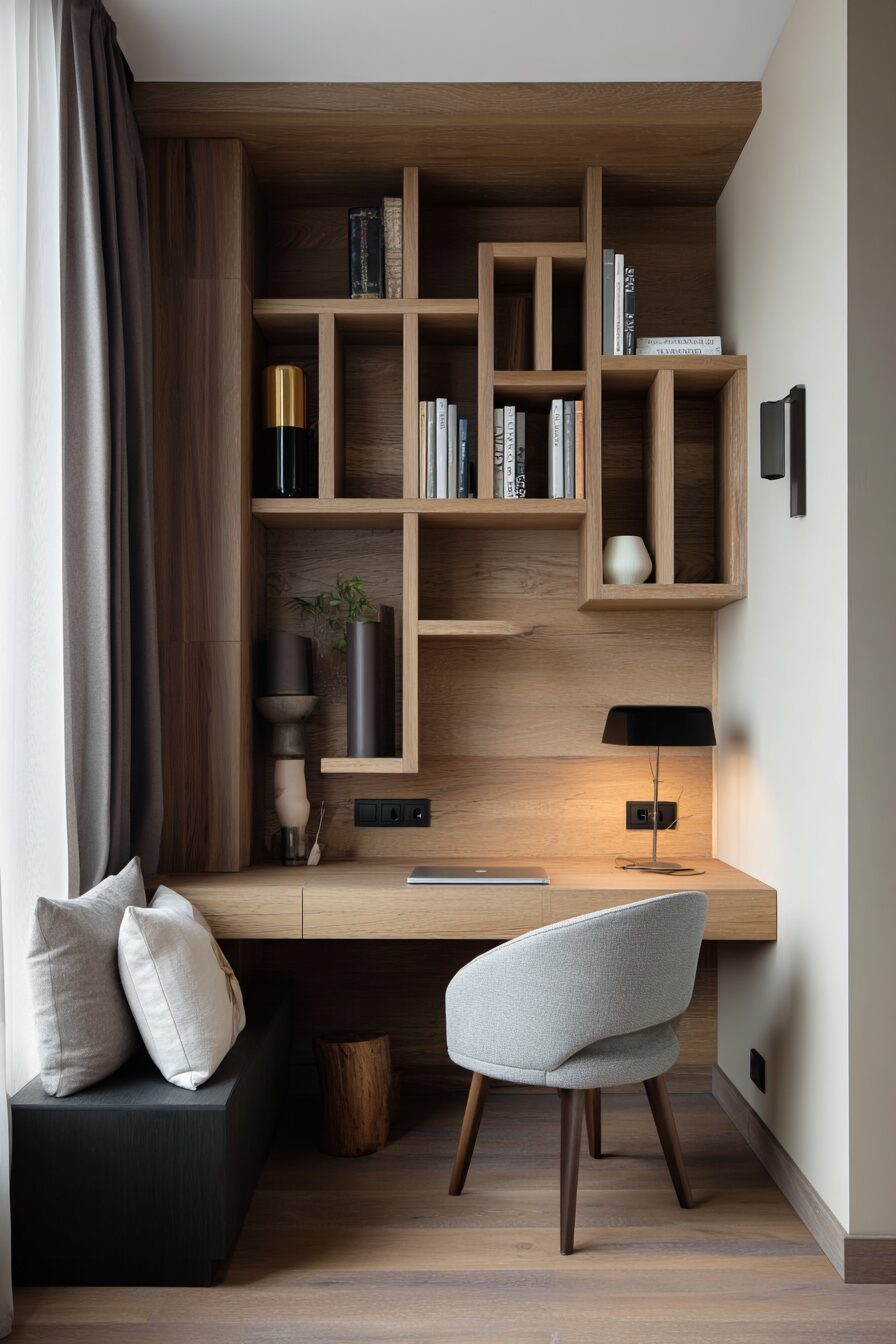Struggling with a cramped room that feels more like a storage closet than a living space?
Your walls are untapped real estate waiting for the right floating shelves to transform both storage capacity and style factor.
These DIY floating shelf projects are specifically designed for small spaces, combining clever placement with eye-catching design to maximize every square inch of your room while adding serious visual appeal.
Corner Floating Shelves That Turn Dead Space Into Your Favorite Feature

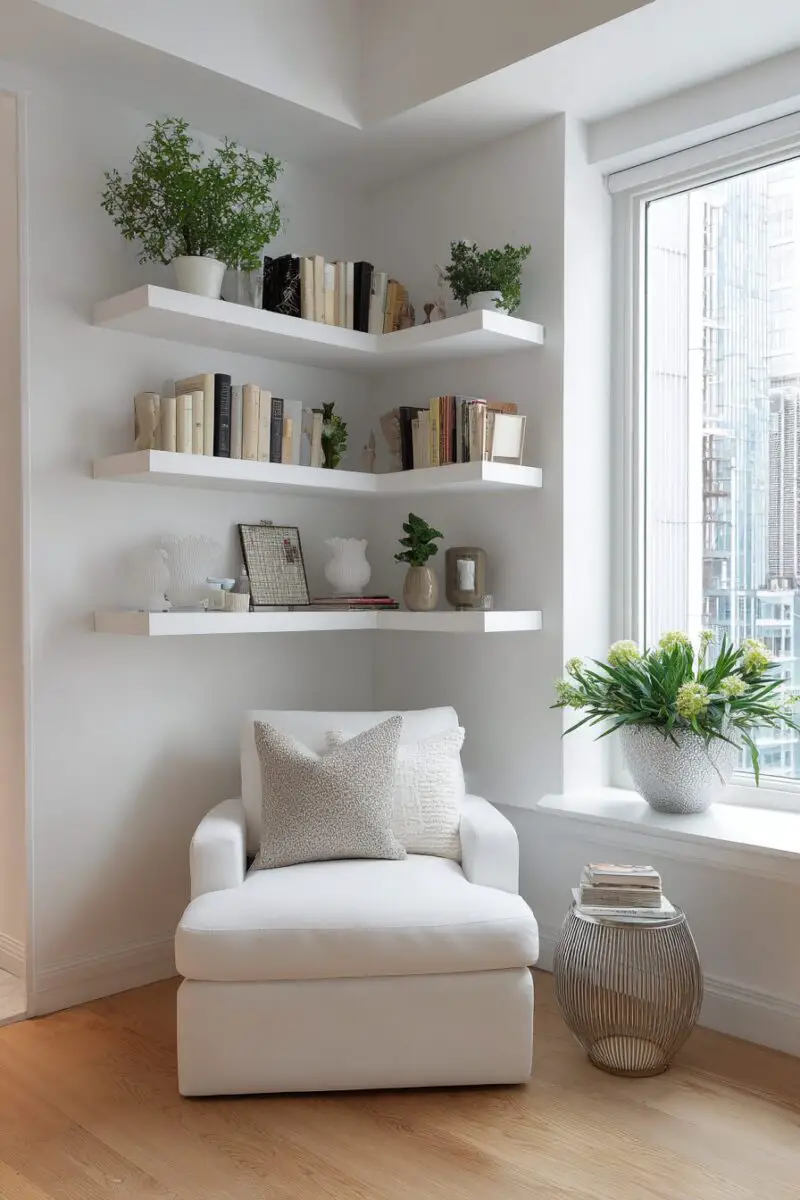
Corner spaces often sit unused, collecting dust and wasting valuable square footage in rooms where every inch counts.
Transform these forgotten angles into stunning focal points with corner floating shelves that fit perfectly into those 90-degree wall intersections.
The beauty of corner shelves is that they utilize space that traditional furniture simply can’t occupy, instantly adding storage without sacrificing any floor area.
For the easiest version, purchase pre-cut wooden triangles from your local hardware store and mount them using hidden bracket systems designed specifically for corners.
For a more custom approach, measure your corner dimensions and cut plywood or solid wood boards into perfect triangles that maximize the available depth.
Stain or paint these triangular shelves in a color that either matches your wall for a seamless look or contrasts boldly to create a striking design element.
Install them in a staggered pattern up the corner to create visual interest and provide different sized spaces for various items.
Corner shelves work particularly well for displaying collections of small items like succulents, vintage figurines, or your favorite paperbacks.
For added functionality in a bedroom, place a corner shelf at nightstand height and install a small sconce above it to create a bedside station without the bulk of traditional furniture.
In home offices, corner shelves above your desk provide the perfect spot for reference materials and decorative elements that inspire creativity without cluttering your workspace.
For bathrooms, corner shelves efficiently store toiletries and decorative elements in a space that’s often tight and lacking storage.
The most sophisticated corner shelf designs incorporate LED strip lighting underneath each level, creating a floating effect that illuminates your items while adding ambient lighting to your room.
When properly installed, corner floating shelves create the illusion of more space while simultaneously providing practical storage that keeps your small room organized and visually appealing.
Invisible Bracket Shelves That Create Mind-Bending Visual Magic
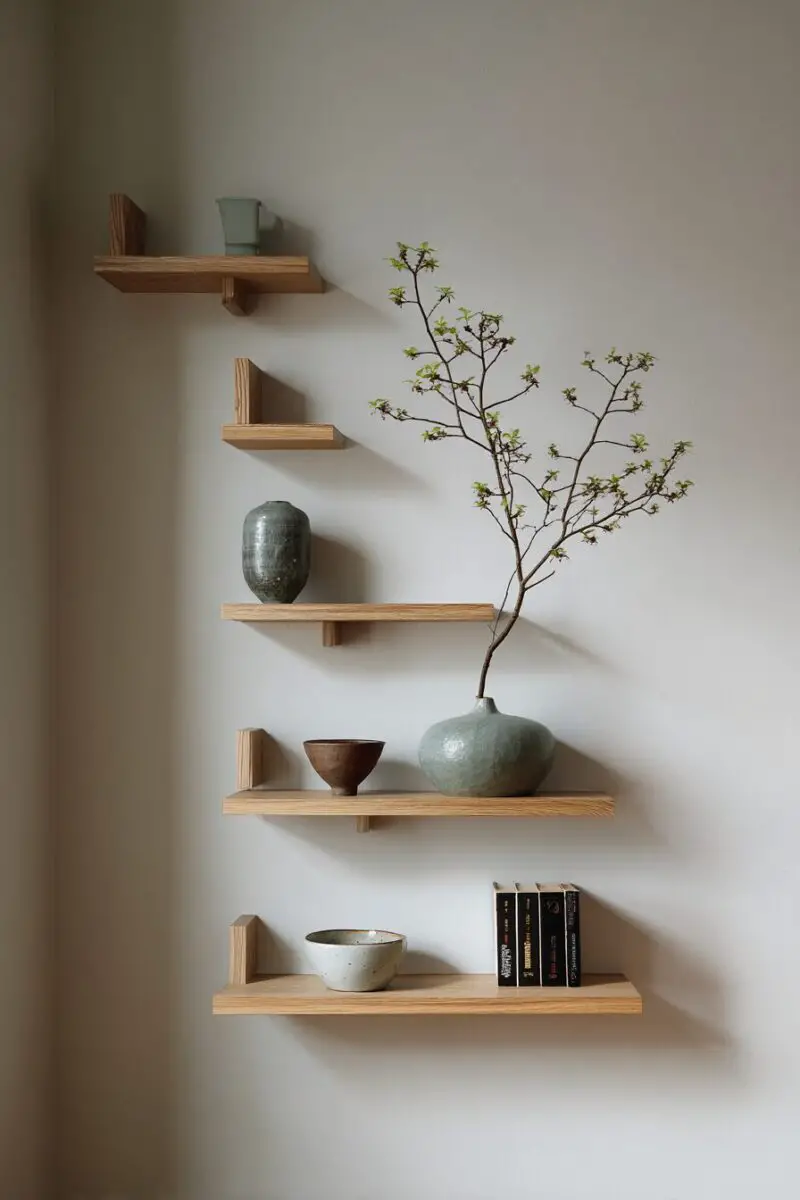
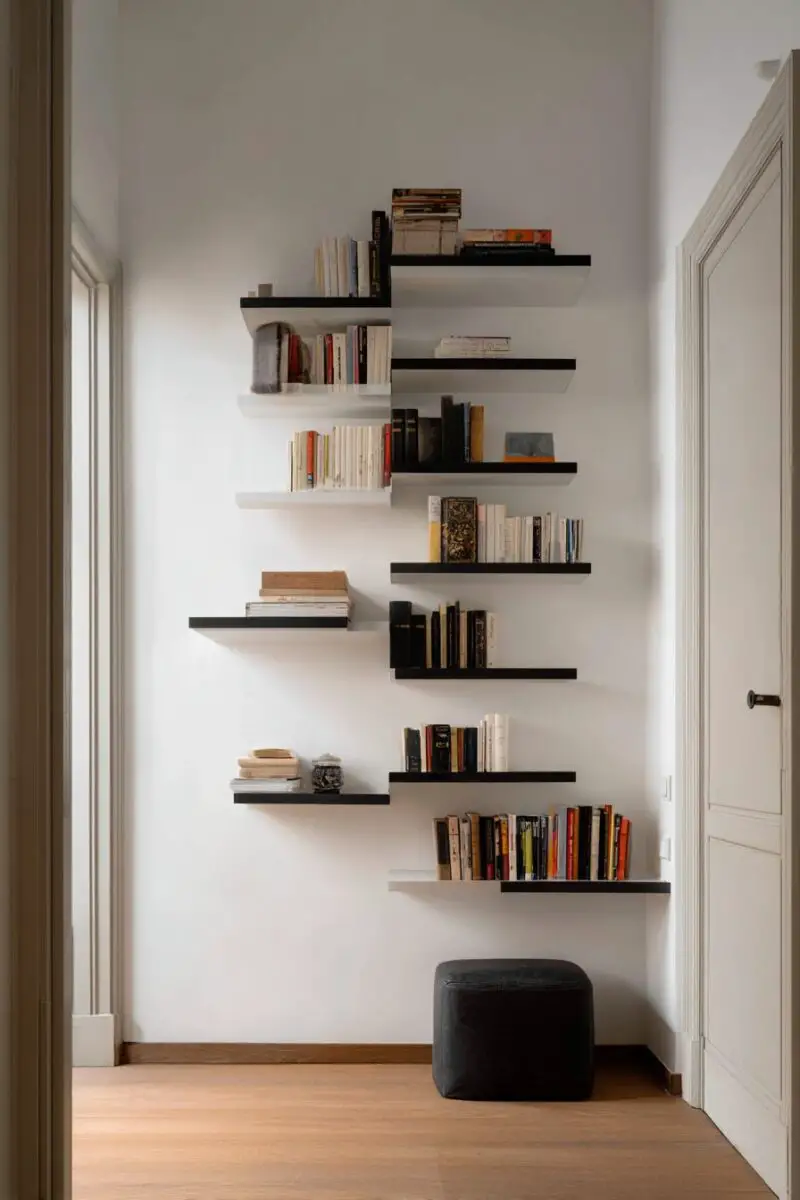
Nothing screams “custom high-end design” like shelves that appear to float effortlessly against your wall with no visible means of support.
These invisible bracket shelves create a clean, minimalist aesthetic that’s perfect for contemporary small spaces where visual clutter needs to be minimized.
The secret lies in specialized hidden brackets that install inside the shelf itself, transferring the load to sturdy wall studs while remaining completely concealed from view.
Creating this type of shelf requires more precision than standard bracket shelves, making it slightly more challenging but infinitely more impressive when completed.
Start by selecting hardwood at least 1.5 inches thick to accommodate the hidden bracket hardware without compromising structural integrity.
Carefully mark and drill precise holes in both the wall and the shelf to ensure perfect alignment—even a few millimeters off can ruin the floating effect.
Use a router to create channels along the back of your shelf where the metal bracket arms will sit flush, completely hidden from view when installed.
The most dramatic invisible bracket shelves use thick wood slabs with live edges, creating the appearance of a slice of tree magically suspended on your wall.
For small rooms, limit the depth of these shelves to 6-8 inches to preserve precious space while still providing useful storage.
Paint or stain these shelves in the exact color of your wall for a truly mind-bending effect where the shelf seems to disappear into the wall itself.
Alternatively, choose a bold contrasting color or rich wood tone to make the shelves stand out as floating design elements against your wall.
The cleanest installations include hiding any wiring inside the shelf to accommodate small lamps or charging stations, eliminating cord clutter.
Invisible bracket shelves work particularly well in minimal Scandinavian-inspired spaces where clean lines and uncluttered surfaces are design priorities.
The visual lightness of these shelves makes them perfect for small rooms where heavy-looking furniture would make the space feel cramped and confined.
Design Your Dream Room in Minutes!
🏡 Start Creating FREE →Reclaimed Wood Floating Shelves That Tell a Story While Saving Space
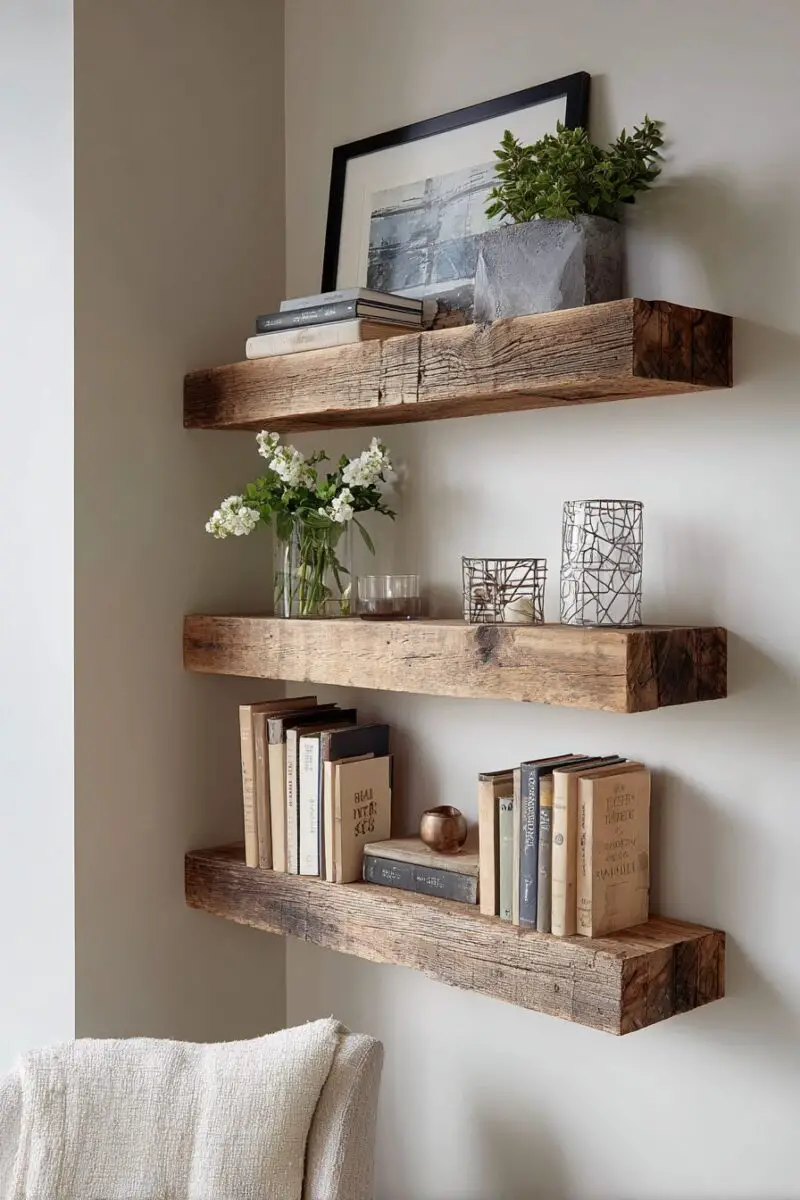
Nothing adds character to a small room quite like shelves crafted from wood with a history and visible patina that can’t be replicated by mass-produced furniture.
Reclaimed wood floating shelves bring warmth, texture, and sustainable design to your space while providing practical storage that doesn’t consume valuable floor area.
The beauty of reclaimed wood is that each piece has unique grain patterns, nail holes, saw marks, and color variations that tell the story of its previous life.
Barns, factories, old homes, and shipping pallets all provide excellent sources for wood that can be transformed into stunning shelves with minimal processing.
For the most authentic look, preserve the original saw marks, nail holes, and weathered patina rather than sanding everything away to pristine smoothness.
Pair these rustic wood elements with industrial-style metal brackets for a perfect blend of raw materials that complement each other beautifully.
For a more dramatic floating effect, hollow out the back of thicker reclaimed beams to hide mounting hardware while maintaining the substantial appearance of solid wood.
Railroad ties, old floor joists, and barnwood are particularly suited for creating deeper shelves that can hold books and larger decorative items.
Apply several coats of clear polyurethane to protect the wood and seal in any old paint or patina while making the surface practical for daily use.
In small bathrooms, reclaimed wood shelves create a spa-like warmth that contrasts beautifully with cool tile and porcelain fixtures.
For tiny kitchens, these shelves provide open storage for frequently used items while adding architectural interest to basic builder-grade spaces.
The natural variation in reclaimed wood pairs surprisingly well with modern elements, creating an appealing tension between old and new in compact spaces.
When selecting your wood, look for pieces with interesting knots, grain patterns, or color variations that will make each shelf a unique focal point.
The stories behind your reclaimed wood—whether it came from a 100-year-old barn or local factory—add conversation starters to your small space that mass-produced shelving simply can’t match.
Floating Box Shelves That Double Your Storage Through Clever Design

Traditional flat shelves offer one-dimensional storage, but floating box shelves provide both a surface for display and hidden compartments that maximize functionality in tiny spaces.
These ingenious storage solutions look like simple floating shelves from the front but conceal deep storage boxes that can hide clutter and organize small items.
The boxed design creates structural strength that allows these shelves to hold surprising amounts of weight despite their floating appearance.
Building box shelves requires more materials and woodworking skill than basic shelves, but the added storage capacity makes them worth the extra effort in space-challenged rooms.
Start with a simple rectangular box construction using 1/2-inch plywood for the sides and back, adding a solid wood face frame for a more finished appearance.
Create hidden finger pulls along the bottom edge or install small hardware that blends with your design for easy access to the concealed storage area.
For the most streamlined look, use push-latch hardware that opens with a gentle press and closes with a soft push, eliminating visible handles entirely.
Box shelves work particularly well in entryways, where the top surface displays decorative items while hidden compartments store keys, mail, and other daily essentials.
In home offices, these shelves keep supplies and paperwork hidden away while maintaining a clean, productive environment free from visual distractions.
For an advanced version, install a hinged lid on top rather than a pull-down front, allowing the entire surface to lift and reveal storage while maintaining the appearance of a solid shelf when closed.
LED lighting installed inside these compartments makes finding small items easier while adding a dramatic glow when the storage area is opened.
Paint these box shelves the same color as your wall for a seamless built-in look, or choose contrasting colors for the interior and exterior to create visual interest.
In bedrooms, a floating box shelf can replace a traditional nightstand, providing both a surface for a lamp and book while hiding personal items in the concealed storage area.
Geometric Honeycomb Shelves That Transform Walls Into Living Art

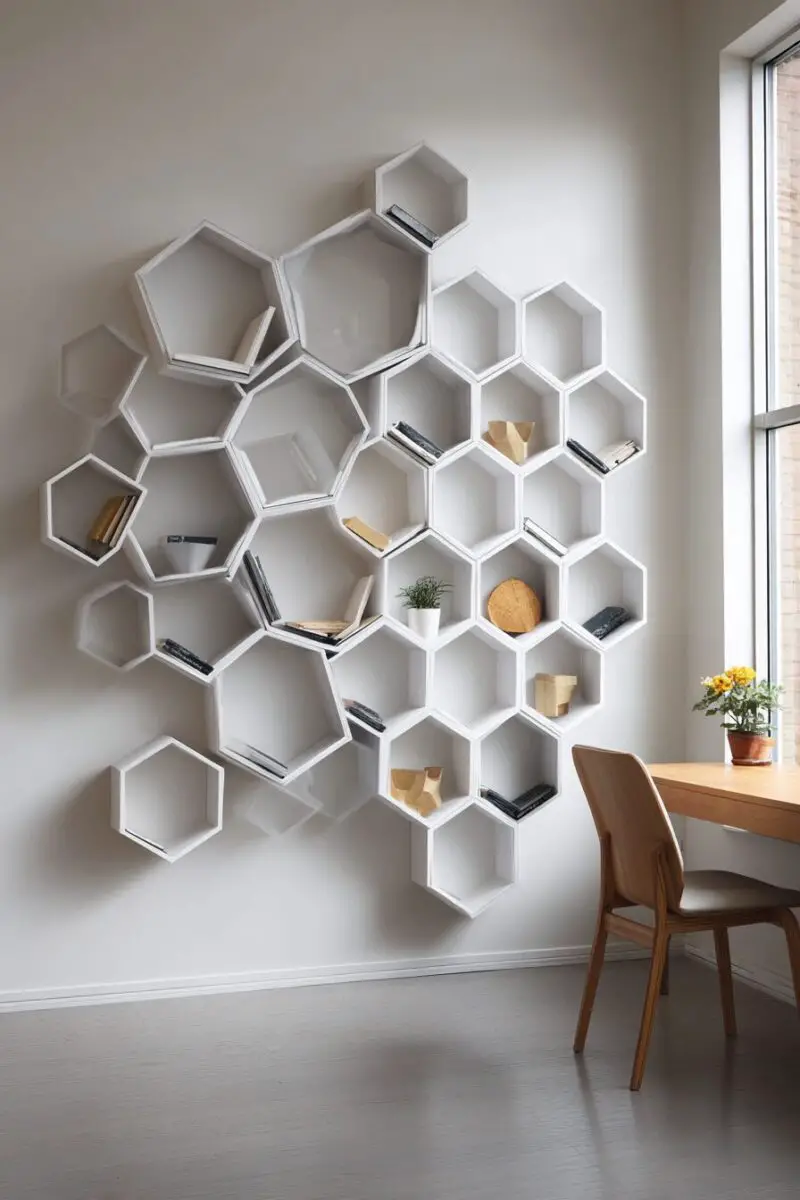
Forget boring straight shelves—hexagonal honeycomb shelves turn your wall into a living sculpture that stores your items within a mathematically pleasing pattern.
These eye-catching geometric shelves create instant visual interest in small spaces while providing modular storage that can be arranged to fit any wall configuration.
The hexagon shape offers more interesting display opportunities than standard rectangular shelves, with angles that showcase your items from multiple perspectives.
Constructing honeycomb shelves requires precise 30-degree angle cuts, making a miter saw or good quality miter box essential for clean joints.
For the simplest approach, create individual hexagons of the same size that can be arranged in various patterns depending on your wall space and storage needs.
More advanced designs incorporate hexagons of different sizes that nest together like a puzzle, creating visual rhythm and allowing for storage of differently sized items.
Thin plywood works well for these shelves, keeping them lightweight while providing adequate strength when the hexagon shape is fully assembled.
Connect the hexagon sides with wood glue and reinforcing staples or brad nails, creating rigid geometric forms that can be mounted securely to your wall.
Paint your honeycomb shelves in a monochromatic color scheme for sophisticated modern appeal, or try an ombré effect that transitions from light to dark across the arrangement.
For the boldest statement, paint each hexagon a different complementary color to create a vibrant focal wall that energizes your small space.
Mount these geometric shelves with hidden keyhole hangers on the back for a clean floating appearance that maintains the sculptural quality of the design.
Arrange your hexagons to follow the contours of your furniture, creating a design that appears to grow organically up and around the room’s existing elements.
These shelves work particularly well for displaying small collections, air plants, or lightweight decorative objects that don’t require deep storage space.
The uniqueness of honeycomb shelving immediately draws the eye upward, employing vertical space and creating the perception of a larger, more interesting room.
TRENDING NOW
DIY Candle Holder Crafts from Recycled ItemsFloating Picture Ledge Shelves That Rotate Your Art Without Damaging Walls
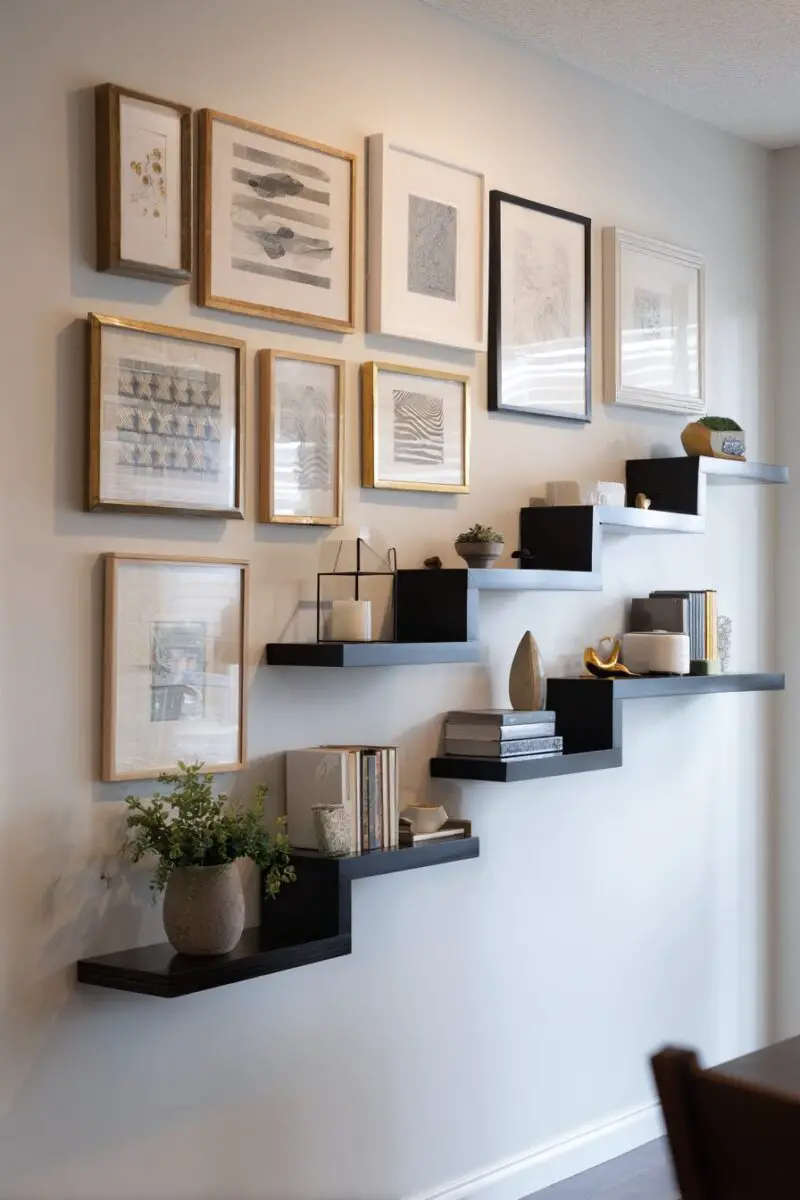
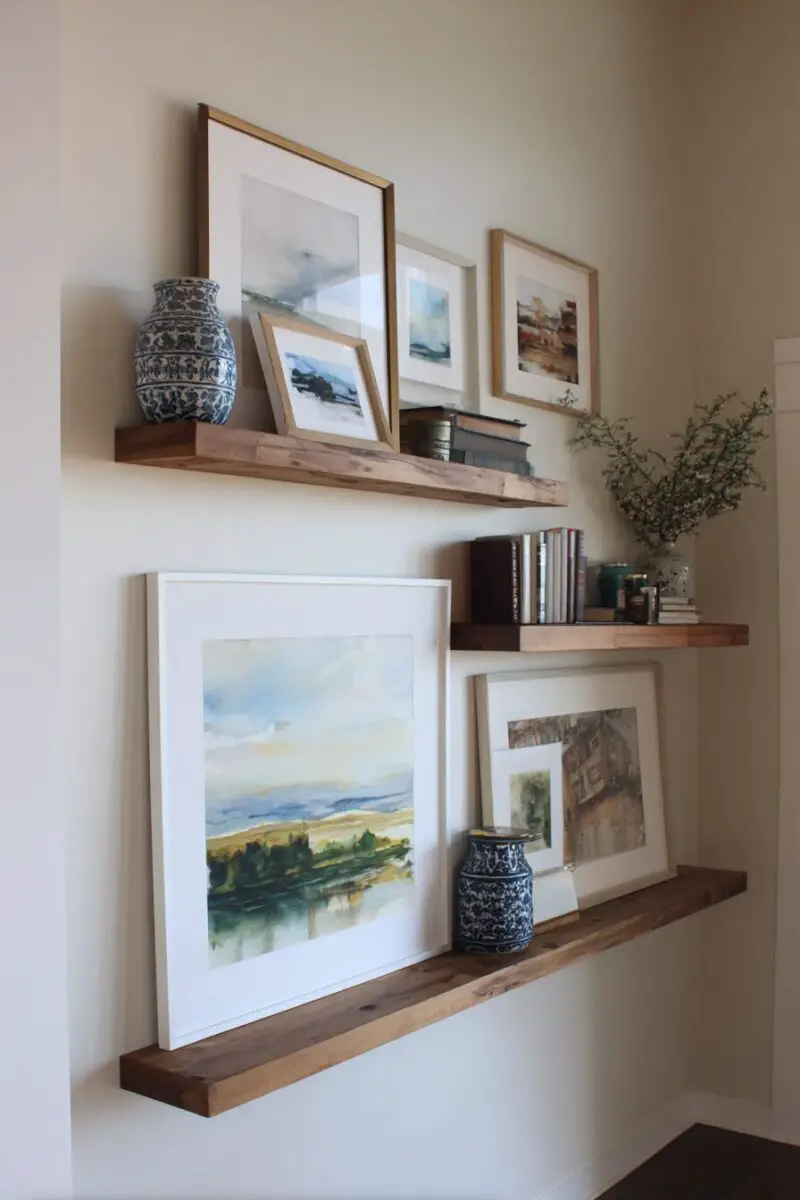
Traditional art hanging requires multiple nail holes and permanent commitment to placement, but floating picture ledges let you change your displayed items on a whim.
These narrow shelves feature a small lip or ridge at the front edge that prevents framed artwork, photographs, and books from sliding off while allowing easy rearrangement.
The beauty of picture ledge shelves is their shallow depth—typically only 2-3 inches—making them perfect for narrow hallways and tight spaces where deeper shelves would protrude too far.
Because they’re designed to hold items that lean against the wall, picture ledges require less complicated installation than shelves meant to bear heavy loads.
Create these simple yet effective shelves using a 1×3 board for the base with a 1×2 strip attached along the front edge to create the retaining lip.
For an even sleeker profile, use a single piece of hardwood with a groove routed along the upper edge to create the lip that holds your displayed items.
Install a series of picture ledges at different heights to create a gallery wall effect that can be constantly refreshed without new nail holes or wall damage.
In a home office or creative space, these shelves provide inspiration by allowing you to rotate reference materials, color palettes, and visual inspiration as projects change.
For parents of young artists, picture ledges display children’s artwork in a way that makes regular rotation simple, ensuring every new masterpiece gets its moment of glory.
The narrow profile of these shelves makes them perfect for awkward spaces like the wall beside a door or between closely spaced windows where standard shelving won’t fit.
Paint your picture ledges the same color as your wall for a seamless look where only your displayed items stand out, creating a floating gallery effect.
For added functionality in bedrooms or living areas, install a picture ledge at table height to serve as a narrow console that holds a lamp and a few essential items.
In kitchens, these slim shelves display cookbook collections and recipe cards within easy reach without consuming precious counter space.
The versatility of picture ledge shelves means your small space can have an entirely new look each season simply by swapping out the displayed items.
TRENDING NOW
Explore Unique DIY Banquette Seating DesignsUnder-Window Floating Shelves That Reclaim Normally Wasted Space
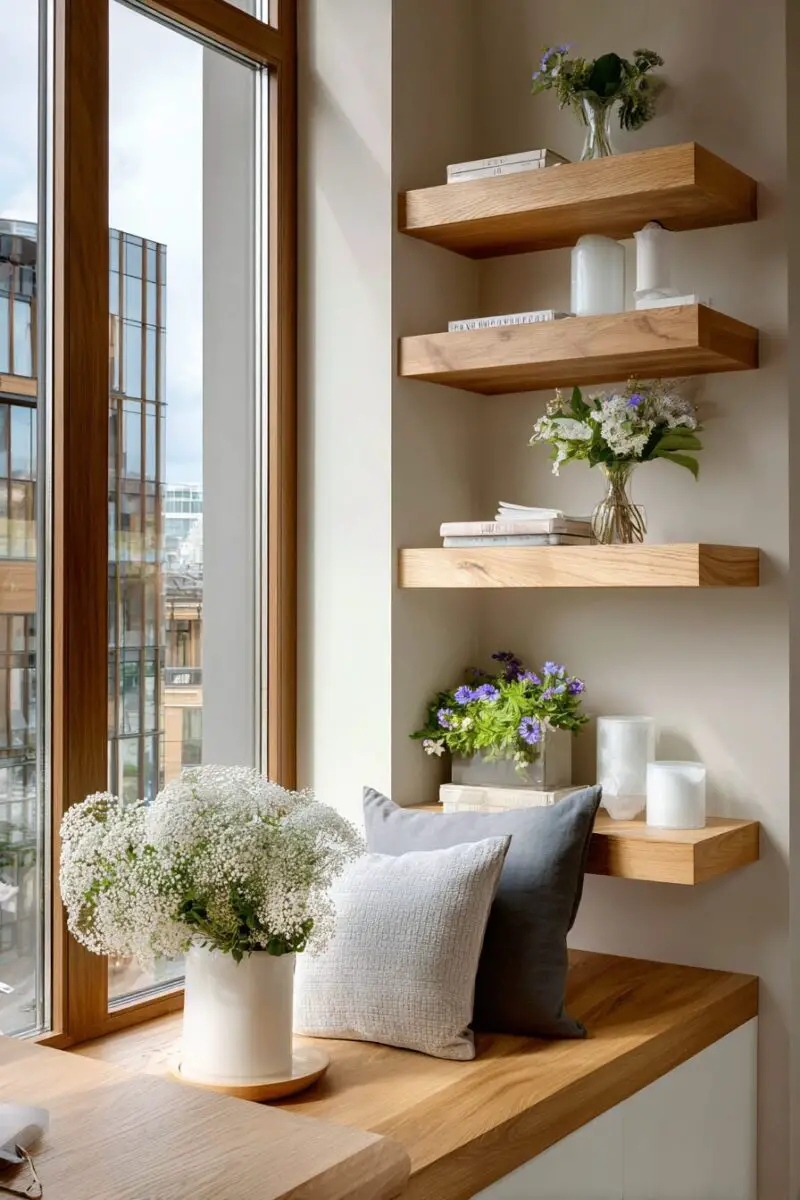
The wall area beneath windows typically sits unused, but custom-sized floating shelves transform this dead space into valuable storage and display opportunities.
Under-window shelves take advantage of natural light to showcase plants, collections, or books while utilizing wall space that would otherwise remain empty.
These shelves can be built to the exact width of your window opening, creating a custom built-in appearance that looks intentional rather than like an afterthought.
For the most cohesive look, match the depth of your under-window shelf to your windowsill, creating a visual extension that feels architecturally integrated.
In bedrooms, an under-window shelf can serve as a cozy reading nook when paired with floor pillows or a small stool that tucks underneath when not in use.
For living rooms, this space becomes the perfect spot for displaying family photos where natural light brings out their best details throughout the day.
In home offices, an under-window shelf at desk height can extend your workspace horizontally, providing extra surface area without requiring additional furniture.
Plant lovers can create a gorgeous garden shelf where sun-loving specimens thrive in the direct light while adding natural beauty to the room.
For the most polished installation, consider adding small finishing returns on the exposed ends of the shelf so no raw edges are visible from any angle.
Incorporate subtle drainage solutions if you’ll be placing many plants on these shelves, such as a removable metal tray or sealed wood surface that protects the shelf from water damage.
When installing under-window shelves, be careful to use proper anchors that won’t interfere with any in-wall heating systems that may run beneath the window.
For added functionality in living spaces, install two parallel shelves beneath wider windows—one at windowsill height for display and one lower shelf for books and storage.
In children’s rooms, under-window shelves provide accessible storage for frequently used toys and books without consuming precious floor space needed for play.
The natural framing created by the window above these shelves creates a built-in visual boundary that makes even simple displays look intentionally designed and curated.
TRENDING NOW
DIY Macrame Plant Hanger TutorialFloating Nightstand Shelves That Eliminate Bulky Bedroom Furniture
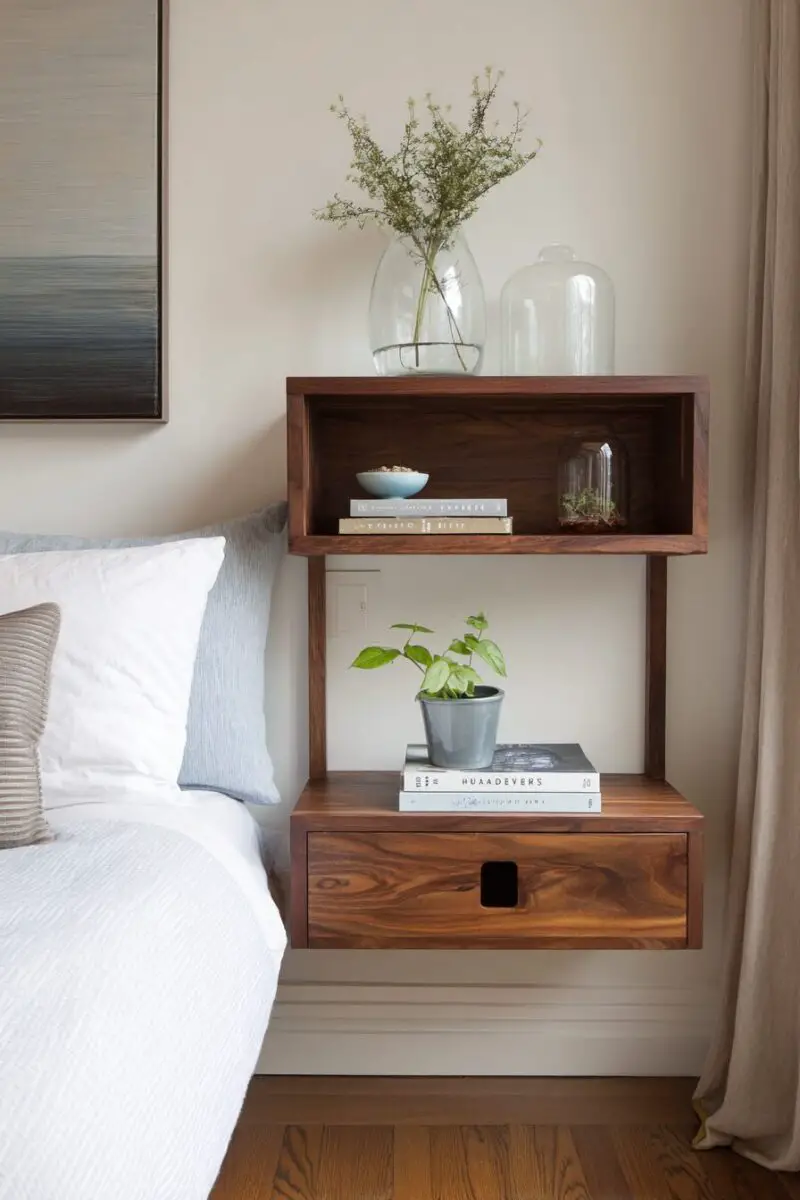
Traditional nightstands consume valuable floor space and limit furniture arrangement options, but floating nightstand shelves free up visual and physical space in tiny bedrooms.
These wall-mounted alternatives to conventional bedside tables provide essential functionality while creating the illusion of more floor space—a critical psychological trick in small rooms.
The floating design allows for easier cleaning underneath, eliminating dust-collecting corners and crevices that come with standard furniture pieces.
For the most functional floating nightstand, create a two-tier design with a larger lower shelf for books and water glasses and a smaller upper shelf for alarm clocks and reading glasses.
Add a small drawer beneath the main shelf surface for storing personal items that you’d rather not have visible, creating a perfect balance of open and closed storage.
Install subtle LED strip lighting underneath to create a gentle glow for nighttime navigation without disturbing your partner with harsh overhead lights.
For tech-friendly bedrooms, incorporate a small hole at the back of the shelf for charging cables to pass through, keeping your devices powered while eliminating cord clutter.
Mount these nightstand shelves at the precise height that works with your mattress—typically 2-3 inches above mattress level for the most comfortable reaching distance.
For tight spaces, consider a corner floating nightstand that tucks into the intersection of two walls, utilizing space that traditional square furniture can’t effectively occupy.
Choose wood that complements your bed frame to create a cohesive design language throughout your bedroom furniture elements.
For couples with different needs, customize each side of the bed with nightstand shelves of different configurations rather than forcing identical solutions on both sides.
Add small vertical dividers to keep books upright or to create separate sections for different types of bedside essentials.
In guest rooms, floating nightstands signal sophisticated design while providing visitors with just enough space for overnight essentials without overwhelming the room.
The space saved by eliminating bulky nightstands often allows for a larger bed or better traffic flow—critical improvements in rooms where every inch matters.
Wraparound Corner Floating Shelves That Create Continuous Storage Flow

Standard shelving stops at corners, creating visual interruptions, but wraparound corner shelves create continuous flow that makes small rooms feel larger and more coherent.
These L-shaped or curved shelves turn corners smoothly, allowing your eye to travel uninterrupted around the room rather than stopping abruptly at each wall junction.
The continuous design creates longer usable surface area than individual shelves, allowing for more dramatic displays that command attention and create impactful focal points.
Building wraparound shelves requires precise measurements and either careful mitering for L-shaped corners or advanced woodworking skills for genuine curved designs.
For the simplest approach, create two shelves that meet at a perfect 90-degree angle in the corner, carefully mitered for a seamless junction where they meet.
More advanced builders can create genuine curves using steam-bent wood or by laminating multiple thin layers of plywood around a form to create a smooth corner radius.
Mount these continuous shelves at the same height around multiple walls to create a cohesive design element that visually expands your small room.
In living rooms, wraparound shelves installed near ceiling height draw the eye upward while providing display space for books and decorative objects without consuming floor space.
For home offices, a wraparound shelf at desk height can create an L-shaped workspace that follows the corner of the room while maintaining an open, floating appearance.
Install subtle under-cabinet lighting beneath these shelves to create dramatic shadows and highlights that emphasize the continuous flow around your room.
For the most built-in appearance, paint these shelves the same color as your walls, creating an architectural feature that seems integral to the room rather than added-on.
In kitchens, wraparound open shelving creates accessible storage for frequently used items while maintaining sightlines that make small cooking spaces feel more open.
The psychological impact of continuous shelving creates a sense of expansiveness in small rooms, eliminating the choppy, fragmented feeling that can make tiny spaces feel cramped.
TRENDING NOW
Inspiring Vision Board Ideas to Manifest Your DreamsFloating Desk With Integrated Shelving That Creates a Complete Workspace
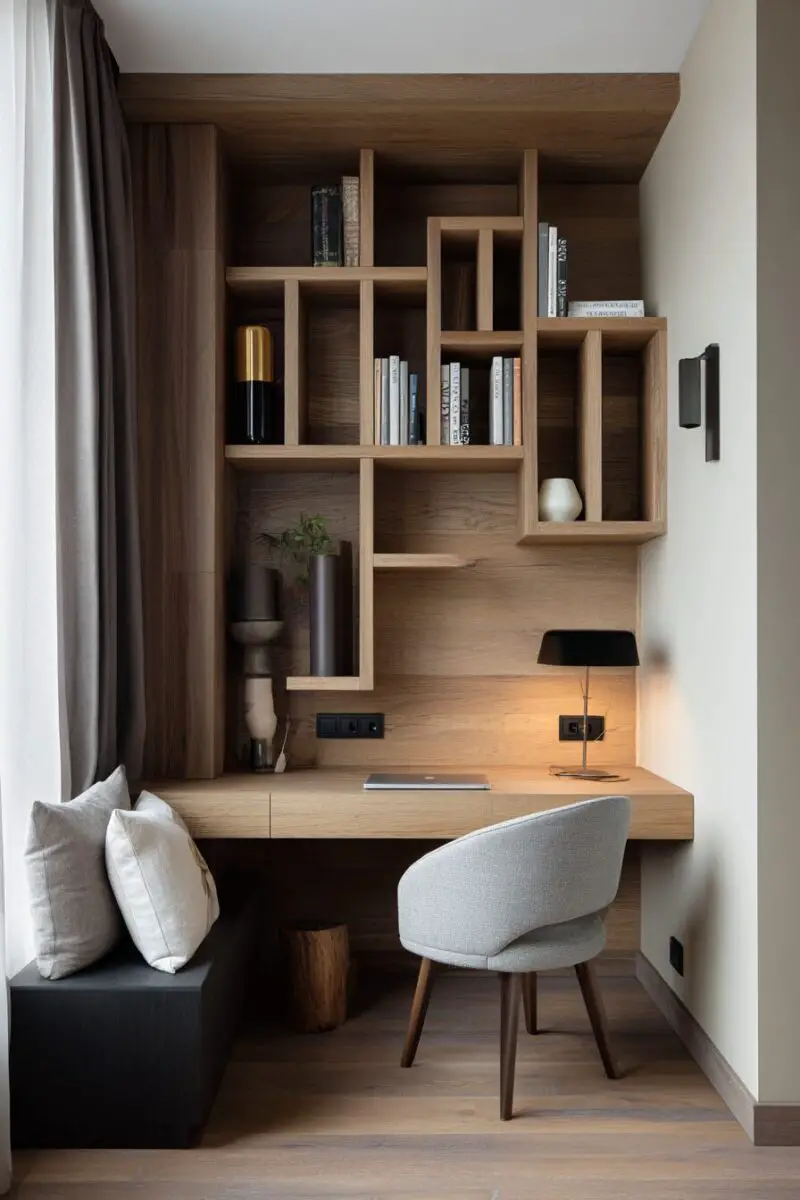
Conventional desks consume massive floor space, but a wall-mounted floating desk with integrated shelving creates a complete workspace using only vertical wall area.
This ingenious solution combines your work surface and storage in one cohesive unit that appears to float effortlessly against your wall.
For maximum stability, construct your floating desk using 3/4-inch plywood or solid wood, ensuring it can support the weight of computers, books, and active use.
Mount the desk surface securely to wall studs using heavy-duty brackets, reinforcing the connection with additional support cleats for worry-free daily use.
Design integrated shelving above the desk to hold reference materials, decorative elements, and office supplies within easy reach but off your main work surface.
Create vertical dividers within the shelving to organize different categories of materials, preventing your workspace from becoming cluttered and chaotic.
Add a small pencil drawer directly under the desk surface for storing frequently used small items that would otherwise clutter your main workspace.
For tech-friendly functionality, incorporate a hidden channel at the back of the desk for routing power cords and charging cables, keeping them organized and out of sight.
Install adjustable lighting either mounted to the underside of upper shelves or using space-saving wall sconces that don’t require precious desk surface area.
Choose a desk depth that accommodates your specific work needs—typically 18-24 inches provides enough space for most computer setups without protruding too far into the room.
For extremely tight spaces, design a fold-down desk surface that can be tucked away when not in use, with shelving that remains accessible at all times.
Add cork, whiteboard, or magnetic panels to the wall space between your desk and upper shelving to create functional surfaces for notes and inspiration.
Paint the entire unit in a color that recedes visually (like the wall color) to minimize its apparent size, or choose a bold accent color to make it an intentional focal point.
The beauty of this integrated solution is that it provides a complete home office without the footprint of traditional furniture—perfect for bedrooms, studio apartments, or tiny home offices.
Small rooms don’t have to mean limited storage or style.
With these DIY floating shelf projects, your walls become functional design elements that maximize every inch while showcasing your personality.
The beauty of floating shelves is their customizability—adjust dimensions, materials, and placement to perfectly suit your unique space.

